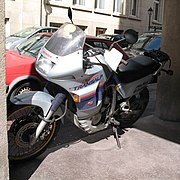 | |
| Manufacturer | Honda |
|---|---|
| Production | 1987-current |
| Engine | Liquid-cooled, six-valve, 4-Stroke, 52 degrees V-twin engine |
| Top speed | 177 km/h (XL600V) 180 km/h (XL650V) |
| Fuel capacity | 18.0 l (XL600V) 19.6 l (XL650V) |
The Transalp is a dual-sport motorcycle by Honda. Different models have been in production from 1987 to present. It is a versatile motorbike, with capabilities for both long road trips and limited off-road. It features a liquid-cooled, eight-valve, four-stroke 52 degrees V-twin engine, and is closely related to the Africa Twin and Honda Bros 400.
History
The first prototype was built in 1985, as an off-road motorbike with a 500 cm³ engine. Further development introduced an increase to 600 cm³ and more road-oriented features, notably an improved fairing.
Models
The most usual models are
- The XL600V from 1987 - available in the United States in 1989
- The XL650V from 2000
- The XL700V from 2008
Other versions exist, such as the 400 cm³ version aimed at the Japanese market.
The 2008 XL700V engine is a liquid-cooled, eight-valve, four-stroke, single-overhead cam, 52 degree V-twin.The first version output 50 hp at 8000 RPM, increased to 55 hp for the 1989 and 1990 version. Later models returned to the original 50hp.
From 1991, the rear drum brake was replaced by a 240mm disc brake, with a single-piston brake caliper.
The look was altered in 1994, replacing the original square lights, and introducing a new fairing.
In 1996, new 34 mm carburetors were introduced, and the ignition system was redesigned, replacing the electronic condensator model with a microprocessor-driven transistorised system.
The front brake was modified in 1997, introducing a second disc and reducing the diameter to 256mm.
The mass of the motorbike increased over time, from 175 kg for the first models to 218 kg for the latest version.
In 2000, the XL650V Transalp replaced the XL600V, introducing a the engine of the Honda Deauville and Honda Revere. The output increased to 55 hp at 7500 rpm, a torque increase to 5.7 mkg at 5500 RPM, and 4mm bore diameter increase allowing for a 64 cm³ displacement increase. The shock absorbers were redesigned for road use, the exhaust system was updated, the fuel capacity increased by one litre, the control panel was redesigned, and mass diminished by 4 kilogrammes.
In 2007, the XL700V Transalp was introduced, with a new 680 cm³ V52 engine taken from the Honda Deauville and compatible with Euro 3 emission standards. The front wheel diametre was reduced from 533mm to 483mm, the exhaust system was fitted with a cataliser, the lights were redesigned, and ABS was introduced.
The 2008 reinforces the road orientation of the Transalp, with larger tyres, lower saddle and more road-oriented shock absorbers.
Popularity
Honda Transalp is popular especially in Europe and Japan. It has been used in several around the world adventures, such as The Tokyo to London Trip that was made from July to December 1994 by Australian bikers Walter Colebatch and James Mudie.
Technical Data
- Gearbox
- 5-speed constant mesh
- Maximum Power
- XL600V 34.7 kW at 7542 rpm
- XL650V 40 kW at 7500 rpm
- Maximum Torque
- XL600V 49 Nm at 5798 rpm
- XL650V 54 Nm at 5500 rpm
- Average Fuel Consumption
- XL600V 6.7 l / 100 km
- XL650V 8.5 l / 100 km
- Fuel Tank Range
- XL600V 273 km
- XL650V 228 km
Model list

- 1987 1988 XL600V-H and V-J Transalp
- 1989 XL600V-K
- 1991 XL600V-M Transalp
- The rear wheel brake was replaced with a single piston disc system
- 1994 1995 XL600V-R
- 1996 XL600V-T
- 1997 XL600V-V
- The front wheel brake was replaced with a twin disc disc system
- 2000 2002 XL650V-Y V-1 V-2
- The engine displacement is increased from 600 cm³ to 650 cm³
- 2007 XL700V
- Completely redesigned 680cc engine with fuel injection/catalyser,ABS,new smaller front wheel ,new body styling but a smaller tank





0 comments:
Post a Comment